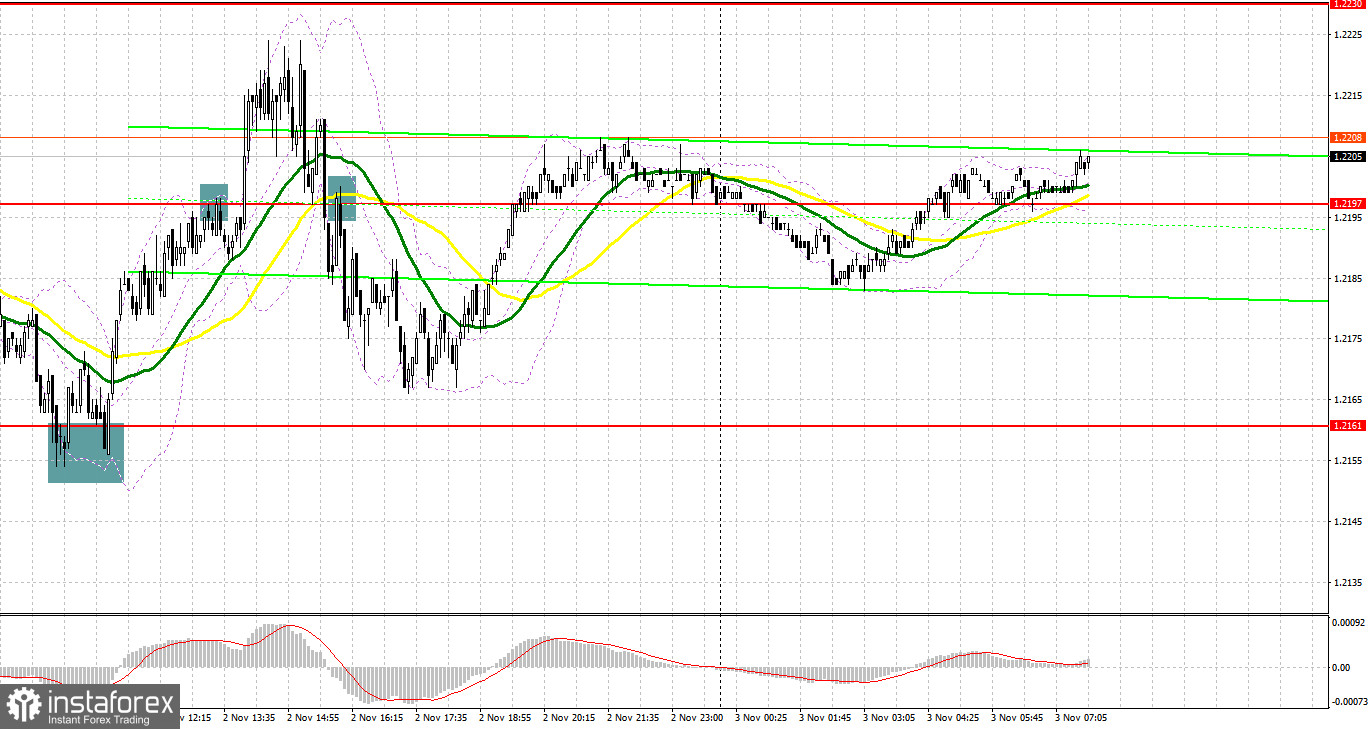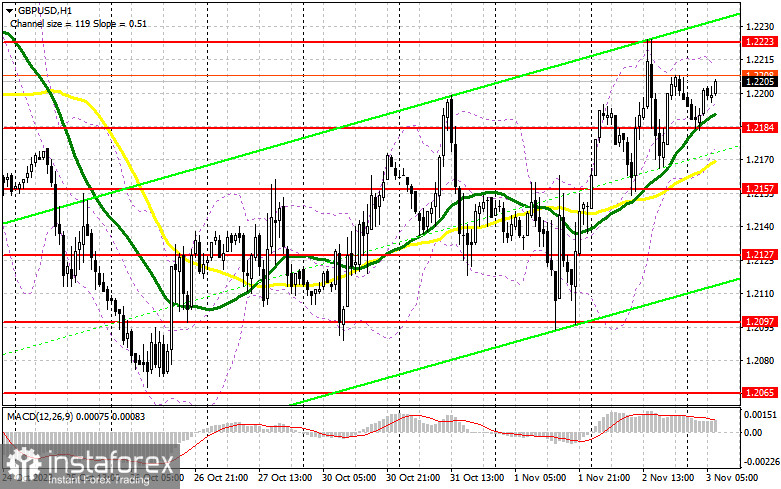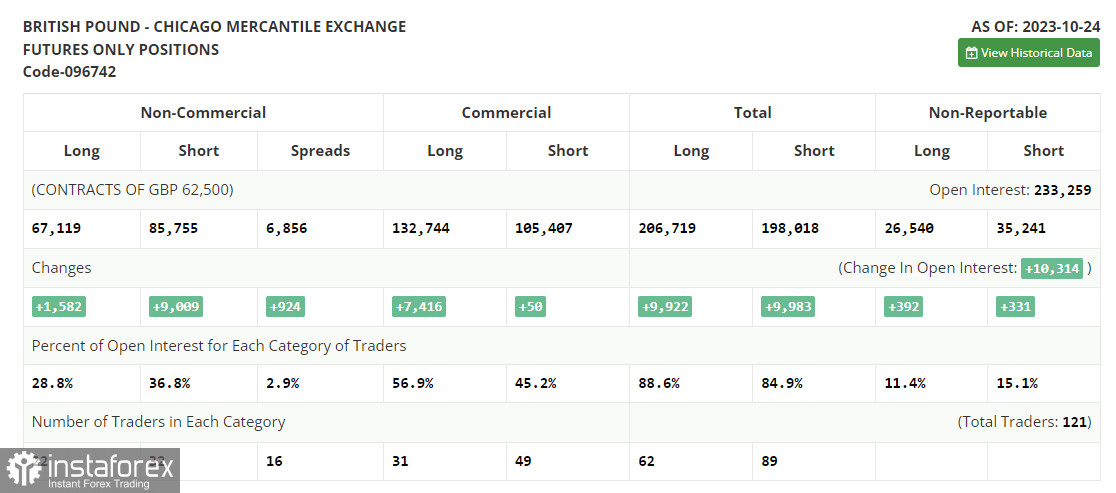Yesterday, the pair formed some great market entry signals. Let's have a look at what happened on the 5-minute chart. In my morning review, I mentioned the level of 1.2161 as a possible entry point. A decline and false breakout at this mark produced a great buy signal, sending the pair up by 40 pips. In the afternoon, a retracement and retest of 1.2197 produced another sell signal. As a result, the pair fell to the 1.2165 area.

For long positions on GBP/USD:
The Bank of England's decision to leave rates unchanged was quite expected, but statements that rates will remain at their highs next year for as long as possible put some pressure on the pair by the beginning of the US session. Revised forecasts for the growth rate of the British economy also exerted pressure on the bulls, which limited the pound's growth potential. Today, we have the Services PMI and the UK Composite PMI coming out, as well as a speech from Bank of England MPC member Huw Pill. Weak data will remind us of the current state of the economy, which will surely exert pressure on the pound, which I advise you to take advantage of. A decline and false breakout at 1.2184, which is in line with the bullish moving averages, will provide an entry point for long positions with an aim to challenge the resistance at 1.2223, formed at the end of yesterday. A breakout and consolidation above this range will allow buyers to return to the market and initiate long positions, potentially targeting the 1.2258 area. The ultimate target is found at 1.2285 where I will be taking profits. Should the pair decline and buyers show no initiative at 1.2184, only a false breakout near the next support level at 1.2157 will signal the opportunity to open long positions. I plan to buy GBP/USD immediately on a rebound from 1.2127, aiming for a correction of 30-35 pips within the day.
For short positions on GBP/USD:
Sellers are slowly losing control of the market, but they could find support in today's data. Weak Services PMI and a false breakout near the nearest resistance level at 1.2223 will produce a sell signal, which could push the pair towards the support level at 1.2184. Just below this level, we have the moving averages that favor the bulls. Breaching this level and an upward retest will deal a more serious blow to the bulls' positions, lead to a cascade of stop orders, and open a path to 1.2157. The more distant target will be 1.2127, where I'd be taking profits. But the pair can only reach this level in the afternoon after the release of US labor market data. If GBP/USD grows and there are no bears at 1.2223, which is where things are headed, demand for the pound will return and buyers might have a chance for a bullish correction. In that case, I will postpone selling until a false breakout at 1.2258. If downward movement stalls there, one can sell the British pound on a bounce from 1.2285, bearing in mind a 30-35-pips downward intraday correction.

COT report:
The Commitments of Traders report for October 24 indicated a rise in both long and short positions, tilting favor towards sellers in the GBP/USD pair. UK economic data remains weak, evidenced by reduced activity in both the manufacturing and services sectors, which points to a slowdown in economic growth. At the upcoming meeting this week, the Federal Reserve is likely to leave its monetary policy unchanged, potentially supporting the pound. However, recent strong US data could lead to hints about a possible rate hike in December, thus strengthening the US dollar. Non-commercial long positions went up by 1,582 to 67,119 while non-commercial short positions jumped by 9,009 to 85,755, increasing the spread by 924 positions. The weekly closing price declined to 1.2165 from 1.2179.

Indicator signals:
Moving Averages
The instrument is trading above the 30 and 50-day moving averages. It indicates that GBP/USD is likely to rise further.
Please note that the time period and levels of the moving averages are analyzed only for the H1 chart, which differs from the general definition of the classic daily moving averages on the D1 chart.
Bollinger Bands
If GBP/USD declines, the indicator's lower border near 1.2170 will serve as support.
Description of indicators:
• A moving average of a 50-day period determines the current trend by smoothing volatility and noise; marked in yellow on the chart;
• A moving average of a 30-day period determines the current trend by smoothing volatility and noise; marked in green on the chart;
• MACD Indicator (Moving Average Convergence/Divergence) Fast EMA with a 12-day period; Slow EMA with a 26-day period. SMA with a 9-day period;
• Bollinger Bands: 20-day period;
• Non-commercial traders are speculators such as individual traders, hedge funds, and large institutions who use the futures market for speculative purposes and meet certain requirements;
• Long non-commercial positions represent the total number of long positions opened by non-commercial traders;
• Short non-commercial positions represent the total number of short positions opened by non-commercial traders;
• The non-commercial net position is the difference between short and long positions of non-commercial traders.





















